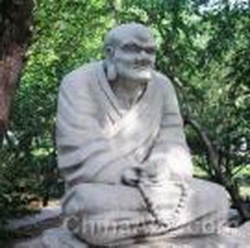Buddhabhadra
Buddhabhadra
[仏陀跋陀羅] (359–429) (Skt; Jpn Buddabaddara)
A monk of northern India who was active as a translator in China. He entered the monkhood in his youth and received instruction in the teachings on meditation in Kashmir. In 408 (406 according to another account) he went to Ch'ang-an in China and propagated the teachings. He assisted Kumarajiva in the translation of Buddhist scriptures, but later he went south, where he was welcomed by Hui-yüan at Mount Lu and lectured on the doctrine of meditation at Hui-yüan's request. Later he lived at Tao-ch'ang-ssu temple in Chien-k'ang and there translated a number of Buddhist scriptures into Chinese. Together with Fa-hsien, he translated The Great Canon of Monastic Rules and the six-volume Mahaparinirvana Sutra. He also translated the sixty-volume version of the Flower Garland Sutra. In total, he is said to have translated 13 works in 125 volumes (some sources say 15 works in 117 volumes), contributing greatly to the development of Chinese Buddhism.
Buddhabhadra (simplified Chinese: 佛陀跋陀罗; traditional Chinese: 佛陀跋陀羅; pinyin: Fótuóbátuóluó) (359-429 CE) was an Indian Buddhist monk, with the title of śramaṇa.
He is most known for his prolific translation efforts of Buddhist texts from Sanskrit into Chinese, and was responsible for the first Chinese translation of the Avataṃsaka Sūtra (Flower Ornament Scripture) in the 5th century CE.
Buddhabhadra and his Chinese disciple Xuangao are known to have advocated the twin principles of samadhi (meditative concentration) and prajna (transcendent wisdom). These were later inherited by the Tiantai school of Buddhism, and its patriarchs Huisi and Zhiyi. Buddhabhadra's views in turn stemmed from those of Buddhasena's Dhyāna school in Kashmir, and their meditation manual was translated by Buddhabhadra at behest of Huiyuan, the founder of the Chinese tradition of Pure Land Buddhism. This Indian meditation manual preserved in Taisho Tripitaka 618, and is typically called the Yogacarabhumi Sutra or the Dharmatrata Dhyana Sutra. This text was later prized by the Zen school in China, and parts of its lineage to the Buddha became entangled in sectarian conflicts between factions of Chinese Buddhism.
